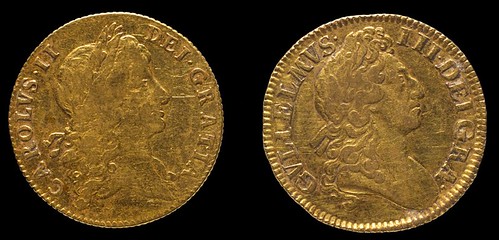
PREV ARTICLE
NEXT ARTICLE
FULL ISSUE
PREV FULL ISSUE
NATIONAL MUSEUM OF IRELAND EXHIBITS COIN HOARD
The article describes an exhibit at the National Museum of Ireland.
-Editor

The earliest coin in the hoard on the left (Charles II- 1664) and the latest coin in the hoard on the right (William III- 1701). Jimmy Deenihan TD Minister for Arts, Heritage and the Gaeltacht formally opened the display of recently discovered 17th Century gold coins from Carrick-on-Suir. The hoard is on display in the National Museum of Ireland - Decorative Arts & History, Collins Barracks. The hoard was discovered on 14th January 2013 by David Kiersey, Shane Comerford, Tom Kennedy, Shane Murray and Patrick McGrath during ground works being undertaken at Main Street, Carrick-on-Suir, Co. Tipperary. The families and close friends of the finders were invited to the Museum to witness the coins being placed on display for the general public. The coins are reported to have been “in a line together” in the ground and may have been wrapped and held together by some material which has not survived. Speaking at the Museum Minister Deenihan thanked each of the finders, and acknowledged their honesty and civic responsibility in immediately coming forward to the relevant authorities and declaring the discovery. "The finders of this important hoard did absolutely the right thing by calling the National Museum. On discovery of this treasure their immediate instinct was to ensure this collection could be saved for viewing by the people and for future generations, and they are to be thanked and acknowledged for this." The find consists of 81 gold coins dating to the reigns of Charles II (1660-85), James II (1685-8), William and Mary (1688-94) and William III (1694-1702). There are 77 guinea and 4 half guinea coins present, with the earliest dating to 1664 and the latest to 1701. The Guinea was a British gold coin minted by the Royal Mint between 1663 and 1814. ‘Guineas’ were so-called because the gold used in making some of them came from Guinea, West Africa and they were minted in four denominations (a half, one, two and five). The Carrick-on-Suir Hoard probably represents the accumulated wealth of a single family over a number of generations, and was collected in the period following the Cromwellian War down to the end of the decade following the Williamite War. It is not known why the hoard was hidden but it is possible that its wealthy Catholic owner may have considered it necessary to hide his portable assets in response to the imposition of the Penal Laws. Many other scenarios are possible and further research is being conducted to try to establish the historical background of the hoard.
To read the complete article, see:
17th century Carrick-on-Suir gold coin hoard goes on display at the National Museum of Ireland
(artdaily.com/index.asp?int_sec=2&int_new=62996#.Ua6SJECNqXg)
The Numismatic Bibliomania Society is a non-profit organization promoting numismatic literature. See our web site at coinbooks.org. To submit items for publication in The E-Sylum, write to the Editor at this address: whomren@gmail.com To subscribe go to: https://my.binhost.com/lists/listinfo/esylum All Rights Reserved. NBS Home Page Contact the NBS webmaster 
|